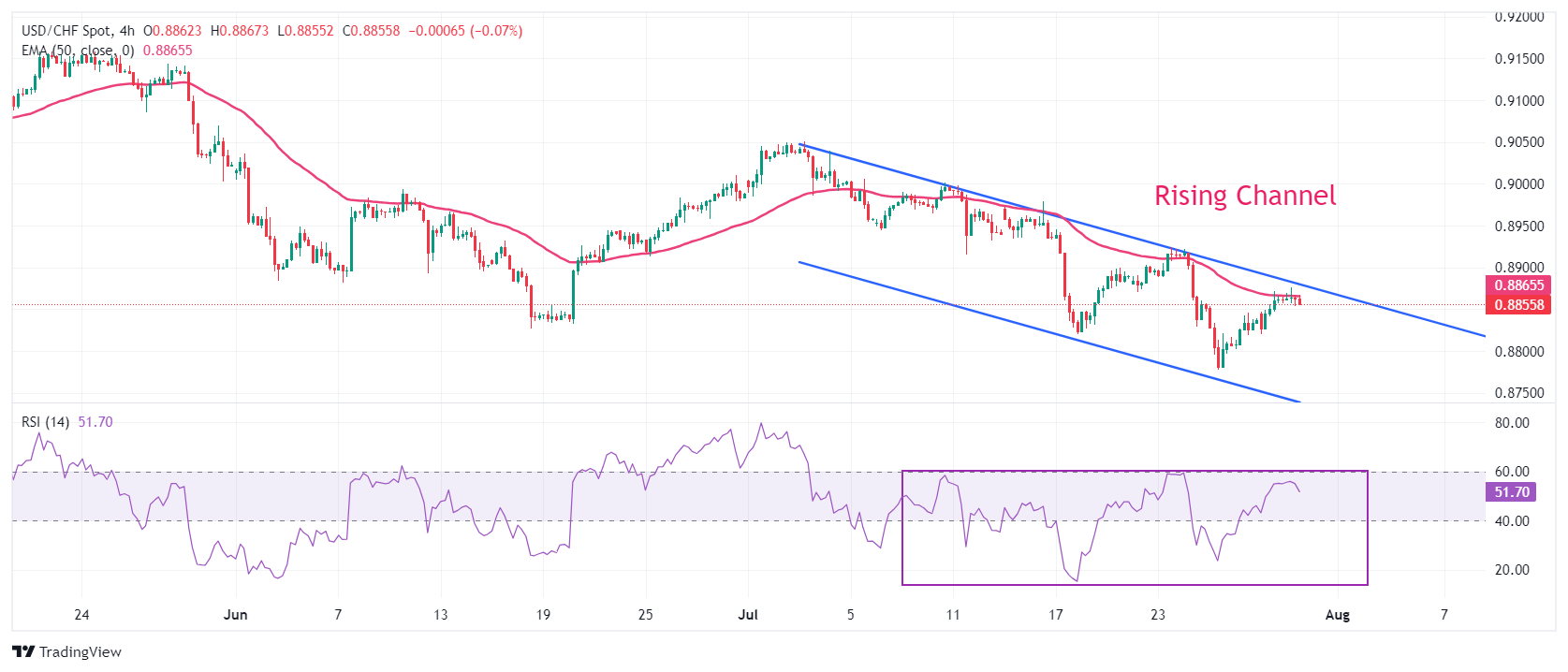USD/CHF Price Analysis: Ranges near 0.8850 in countdown to Fed policy
- USD/CHF consolidates near 0.8850 with a focus on the Fed policy.
- The Fed is expected continue maintaining the status quo.
- Investors will also focus on the Swiss CPI for July.
The USD/CHF pair trades in a limited range near 0.8850 in Tuesday’s American session. The Swiss Franc asset consolidates as investors have sidelined with focus on the outcome of Federal Reserve’s (Fed) monetary policy meeting on Wednesday.
The Fed is expected to leave interest rates unchanged in the range of 5.25%-5.50% for the eighth time in a row. Therefore, investors will focus on the Fed’s guidance on interest rates. In the monetary policy statement and the press conference, Fed Chair Jerome Powell is expected to acknowledge progress in inflation and cooling labor market strength, which would boost expectations that the central bank will start reducing interest rates from the September meeting.
Fed policymakers have admitted that recent inflation readings have suggested that price pressures have returned to their path of 2% but refrained from committing a timeframe for it.
The US Dollar (USD) exhibits a sideways performance in countdown to Fed’s interest rate meeting. In today’s session, investors will focus on the United States (US) JOLTS Job Openings data for June, which will be published at 14:00 GMT.
Meanwhile, the next move in the Swiss Franc (CHF) will be influenced by July’s Consumer Price Index (CPI) data, which will be published on Friday.
USD/CHF trades in a Falling Channel formation, on a four-hour timeframe, in which each pullback move is considered as selling opportunity by market participants. The 50-period Exponential Moving Average (EMA) near 0.8870 continues to act as a major barricade for the US Dollar bulls.
The 14-period Relative Strength Index (RSI) trades in a 20.00-60.00 range near 50.00, suggesting that the overall trend is bearish. While the bearish momentum is inactive.
Going forward, a decisive break above the round-level resistance of 0.8900 will unlock the upside towards July 17 high at 0.8945, followed by the psychological resistance of 0.9000.
In an alternate scenario, a downside move below July 25 low at 0.8777 would expose the asset to March 8 low near 0.8730 and the round-level support of 0.8700.
USD/CHF four-hour chart

Swiss Franc FAQs
The Swiss Franc (CHF) is Switzerland’s official currency. It is among the top ten most traded currencies globally, reaching volumes that well exceed the size of the Swiss economy. Its value is determined by the broad market sentiment, the country’s economic health or action taken by the Swiss National Bank (SNB), among other factors. Between 2011 and 2015, the Swiss Franc was pegged to the Euro (EUR). The peg was abruptly removed, resulting in a more than 20% increase in the Franc’s value, causing a turmoil in markets. Even though the peg isn’t in force anymore, CHF fortunes tend to be highly correlated with the Euro ones due to the high dependency of the Swiss economy on the neighboring Eurozone.
The Swiss Franc (CHF) is considered a safe-haven asset, or a currency that investors tend to buy in times of market stress. This is due to the perceived status of Switzerland in the world: a stable economy, a strong export sector, big central bank reserves or a longstanding political stance towards neutrality in global conflicts make the country’s currency a good choice for investors fleeing from risks. Turbulent times are likely to strengthen CHF value against other currencies that are seen as more risky to invest in.
The Swiss National Bank (SNB) meets four times a year – once every quarter, less than other major central banks – to decide on monetary policy. The bank aims for an annual inflation rate of less than 2%. When inflation is above target or forecasted to be above target in the foreseeable future, the bank will attempt to tame price growth by raising its policy rate. Higher interest rates are generally positive for the Swiss Franc (CHF) as they lead to higher yields, making the country a more attractive place for investors. On the contrary, lower interest rates tend to weaken CHF.
Macroeconomic data releases in Switzerland are key to assessing the state of the economy and can impact the Swiss Franc’s (CHF) valuation. The Swiss economy is broadly stable, but any sudden change in economic growth, inflation, current account or the central bank’s currency reserves have the potential to trigger moves in CHF. Generally, high economic growth, low unemployment and high confidence are good for CHF. Conversely, if economic data points to weakening momentum, CHF is likely to depreciate.
As a small and open economy, Switzerland is heavily dependent on the health of the neighboring Eurozone economies. The broader European Union is Switzerland’s main economic partner and a key political ally, so macroeconomic and monetary policy stability in the Eurozone is essential for Switzerland and, thus, for the Swiss Franc (CHF). With such dependency, some models suggest that the correlation between the fortunes of the Euro (EUR) and the CHF is more than 90%, or close to perfect.
